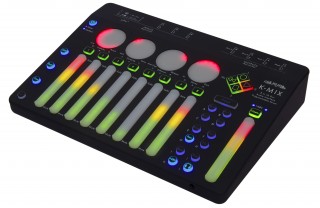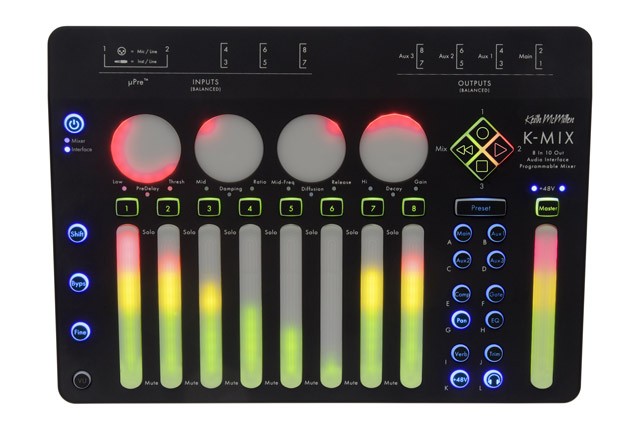 After being previewed at The NAMM Show last winter, Keith McMillen Instruments’ new mixer / audio interface / MIDI controller, the K-Mix, began shipping last week.
After being previewed at The NAMM Show last winter, Keith McMillen Instruments’ new mixer / audio interface / MIDI controller, the K-Mix, began shipping last week.
We got to see an early K-Mix prototype at the 2015 Winter NAMM, but Synthtopia staff won’t have a chance to see the finished version of the product until later this week at the 2016 NAMM Show.
In the meantime, author and research engineer Gina Collecchia has had a recent extended opportunity to check out and work with the K-Mix. She offered to share her impressions and findings with Synthtopia readers:
“The K-Mix mixer by Keith McMillen Instruments is an innovative mixing interface, with a lot of features.
 “Uniting a more traditional mixer interface with LED-lit, opto-tactile “rotaries” and meters, the K-Mix has a similar look and feel to previous KMI products such as the QuNeo and QuNexus.
“Uniting a more traditional mixer interface with LED-lit, opto-tactile “rotaries” and meters, the K-Mix has a similar look and feel to previous KMI products such as the QuNeo and QuNexus.
“The K-Mix boasts “high fidelity” pre-amps and 32-bit floating point audio with up to a 96kHz sampling rate. Putting it through its paces, there is little to no audible difference between the pre-amps of a high end, professional mixer and those on the K-Mix — even measuring slightly more quiet for some frequency ranges. The custom pre-amps require 30mW of power in total, which is 100x less power than regular mixers.

“Ins and Outs. The K-Mix has 8 ins and 10 outs: the first two channels of input have preamps for musical instrument inputs, featuring hybrid XLR / TRS combination jacks. The other six channels (#3 through 8) are 1/4″ TRS jacks, for connecting line level and phono level signals. This means that as many as three sets of turntables or CDJ’s could be plugged in simultaneously.
“The outputs are grouped into stereo buses: channels 1 and 2 could be used for monitoring; the remaining 6 are labeled as “Aux” (auxiliary) outs. The “Aux 1”, “Aux 2”, and “Aux 3″ buttons toggle views to set the send levels of each of the 8 inputs. Channels 9 and 10 of the outputs are routed to a 1/4” inch output in the bottom right corner, which can be used for any number of purposes: as headphone monitoring of any of the four stereo output bus pairs (or individual input channels), as an additional stereo output bus, or as a low-frequency output to a subwoofer. Graphics at the top of the mixer are right there to remind the user of the layout, nicknames, and types of the ins and outs.
“The K-Mix can be bus-powered by USB, or connected to a wall outlet. To connect the K-Mix to to external MIDI hard- ware via MIDI cables, a KMI MIDI Expander is an optional accessory. The MIDI Expander is attached to the K-MIX CONTROL port via USB. A computer is not necessary for the K-Mix to function; all of its DSP effects and output routing are on the device.
“Spatialization.” One innovative feature on the K-Mix is its interface for spatialization. Turning on the Surround feature in the K-Mix Editor, or by pressing “Shift” and then “Pan”, enables the gestures to control panning. The four top rotaries, with KMI’s proprietary SmartFabric sensor technology, enable 3D-like interaction with spatial objects (e.g., any number of the input channels): the pressure on the rotaries controls the spread (or diffusion) of the sound source, as does the proximity of your finger to the center of the rotary. Your finger’s position along the arc of the rotary designates the sound’s spatial position. The panning uses Ambisonics algorithms to ensure a high quality soundstage when working in a surround sound environment. The speaker set up and I/O mapping of the panning is defined on the K-Mix Editor, so a computer is required to configure this feature — but once that’s done, no computer is necessary.
“DSP. Besides surround panning, the K-Mix has four other on-board DSP effects: compression / limiter, noise gating, EQ, and reverb. Each of these are called “Modes”. The four rotaries control four parameters unique to each of the effects. Small LED lights next to the rotaries light up to show the name of the parameter being adjusted for each effect, making the effects view very compact and intuitive.
“Editor. The K-Mix Editor can modify all of the things you can do on the hardware itself, as well as send and receive presets to recall saved states of the K-Mix. Presets are created by pressing “Preset” and then picking one of the 12 Mode buttons (A through L). Presets can also be saved in the K-Mix Editor, but only 12 can be on the mixer at a time. It’s worthwhile to note that the state of the K-Mix will be preserved after power cycling. Monitoring the levels of the output channels is toggled by the “VU” button at the bottom left. While in this view, the input levels can still be adjusted with visual feedback; the view returns to the outputs after a second or two. Channels can be turned on and off quickly, using the usual numbered buttons at the top of each fader. The Master fader at the right has two rows of LEDs for stereo metering.
“The other three buttons on the left, “Fine”, “Byps”, and “Shift”, modify the behavior of a given mode. These buttons — much like the Control, Option, and Command keys on a PC — take some getting used to, mostly in figuring our and remembering which order to press the buttons to get to the desired destination.
- “Shift” switches the state and behavior of the K-Mix hardware according to the selected mode — e.g., EQ mode has its own Shift behavior.
- “Byps” lets you bypass a selected mode (such as Compression Mode) for a specific channel. (This can also be done for all tracks simultaneously, by holding down “Byps” first, and then choosing a mode to bypass for all channels.)
- Finally, the “Fine” button lets you intuitively decrease and increase the faders and rotaries with extra precision. In the “Fine” mode, the rotaries continuously turn unlike in the normal mode, which is restricted to one turn. It can also allow for fine-tuning the parameters of other modes, such as the attack time in Compressor Mode.
“To set up the K-Mix using Ableton Live, set the “Input Config” to make either the mono or stereo inputs available, or both. The inputs and outputs are ready to accept a variety of audio signals such as microphone, line, instrument, and phono.
“All in all, the K-Mix is a compact, robust, feature-packed mixer with MIDI capabilities. Coming in just under one kilogram and with a low profile, musicians and DJs will appreciate how easy it is to carry on the road. This compact mixer is excellent for musicians who want a tactile interface for spatialization, and has great value when considering its size, weight, and ability to double as a MIDI interface.”
K-Mix carries an MSRP of US $599.99 and is available to purchase from any authorized Keith McMillen Instruments dealer or directly from the Keith McMillen Instruments site. Technical details are also available at the KMI site.
About the Author
 Gina Collecchia is a research engineer at SoundHound, Inc. and author of the book Numbers and Notes: An Introduction to Musical Signal Processing (2012, PSI Press).
Gina Collecchia is a research engineer at SoundHound, Inc. and author of the book Numbers and Notes: An Introduction to Musical Signal Processing (2012, PSI Press).
An expert in many areas of digital audio, Collecchia has published papers on room acoustics, music information retrieval, and interface design. Gina holds degrees from Reed College and Stanford University, and currently resides in the Bay Area.
You can find out more about her work at GinaCollecchia.com.


Thinking Behringer XR18 might still be better. More Ins that are all preamps, same number of Outs. PC/Mac comptabile, this is Mac only right now. Could be mapped to Remote SL I already have.
This XR18 doesn’t seem to be a performing tool and there are tons of other interfaces with lots of mic inputs. Can’t really imagine a situation where one synthesist or synth band would need more than few mic inputs on stage.
As submixer for a person with multiple modules you’d need more inputs. I’m an electronic drummer and have 3-4 stereo modules in my rack and want to add 2 more (ipad and computer). Since I’m playing and kind of tweaking my mix, a tactile interface like this would be perfect.
The berringer would be nice for its other capabilities but its too bad if you can’t use a different control surface than an ipad.
The Behringer X18 is iPad only, the Behringer XR18 is for either iOS, Android, Windows or OSX.
http://www.music-group.com/Categories/Behringer/Mixers/Digital-Mixers/X18/p/P0AWZ
http://www.music-group.com/Categories/Behringer/Mixers/Digital-Mixers/XR18/p/P0BI8
I had the same thought and just ordered an XR18 after considering the KMix for a few days and re-watching the sonic state xr18 review.. The amount of functionality for the money is ridiculous and if you already have an iPad or android, then you arguably have a far superior UI to what the KMix could ever offer. I’ve owned the X32 Compact for over a year and absolutely love it. It can stay in the studio while the XR18 can be the heart of my mobile rig.. I can even connect them using the ultranet port. I’m planning to automate it via midi from the Octatrack. Can’t wait to play with it!
I’m using an XR18 and love it. I use between 4 and 7 inputs, depending on my setup, and 2 aux outs. But the thing with the XR18 is that it’s useful for multitrack recording, and I actually ran sound for my entire band at a small outdoor show we did on the 4th of July. And we recorded it — live album, baby. Plus it is great for in-ear monitors, though we’re not using those yet.
Then there’s the XR 12 and 16. Frankly, I can’t recommend the 18 enough, though if you don’t care about multitrack out I recommend the 12. The 16 is too “in between” for my tastes, either save money and go for the 12 or spend the extra bit and get 18 with multitrack-over-usb.
I really like this but I wish each channel could be used as a stereo in, as nearly every module I use has stereo outs.
perfect tool, waited so long for this 🙂
I prefer the soundtrack mtk 12, it is much much more features for less money. With rich analog mixing and 1.5 times more inputs!
With only 8 mono inputs there is not much use for this. Quite a lot features for mini-mixer like that.
Make it four stereo and four mono ins and we are talking! Currently if you connect two stereo outs from laptop and two stereo synths you have 600€ four channel mixer.
note if you have instruments with standard midi connectors (5 pin din) you will need to buy the optional midi expander to connect midi devices as the shipping hardware only supports USB out of the box.
I can’t believe they’re not supporting Windows. No Editor for Windows ?!?!? The manual says some features will be ready on the next firmware update. Yeah right … good luck with that.
Bummed about no windows support, the whole line about USB audio class 2.0 support should read “we kinda don’t want to write our own drivers” instead of passing the blame 100% to Microsoft (which is still stupid, but everyone else, including smaller operations than KM produce drivers…)
Here’s hoping g the update it to support windows!